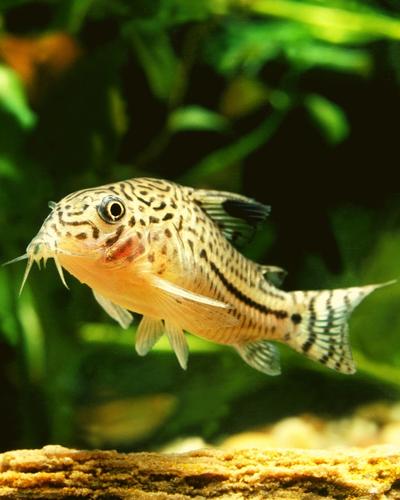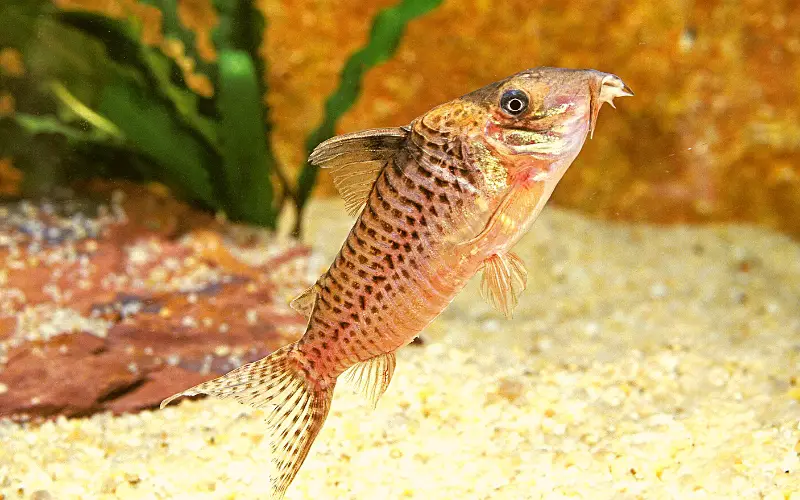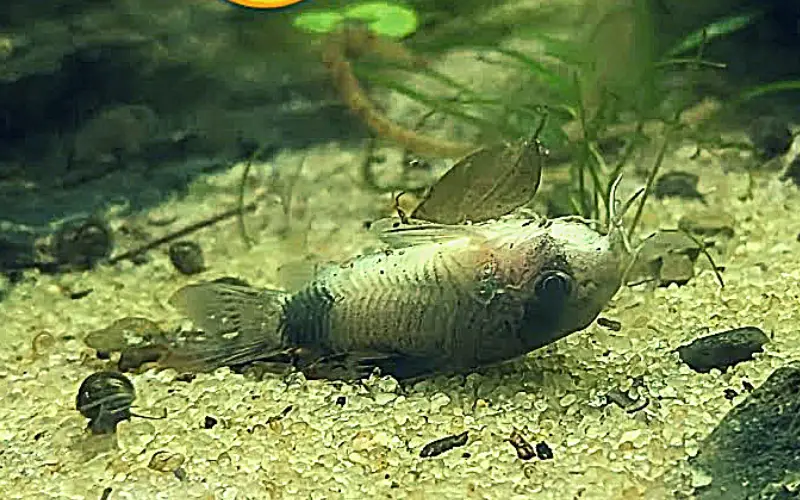Swim bladder disease is a common issue for Cory Catfish, and it can affect the fish’s ability to swim correctly in your tank. Left untreated, this condition can cause poor health in your Cory Catfish, potentially leading to premature death. So, how to fix swim bladder in Cory catfish?
Fortunately, there are steps that you can take to help treat swim bladder disease and get your scavenger back on the road to recovery.
In this blog post, we’ll provide an overview of Cory swim bladder disease and practical advice about how best to fix the issue for your beloved pet fish. Read on for more information!

Table of Contents
ToggleReasons for Swim Bladder Disease in Corydoras Catfish
Swim bladder disease can affect various fish species, including Corydoras catfish. This condition disrupts a fish’s ability to control its buoyancy and swim properly. Several factors can contribute to swim bladder disease in Corydoras’ catfish:
- Overfeeding: Feeding your Corydoras catfish excessive amounts of food or offering high-protein diets can lead to overeating. Over time, this can cause digestive issues and affect the swim bladder’s function.
- Poor Water Quality: Maintaining clean and well-oxygenated water is crucial for fish health. Inadequate water quality can stress Corydoras catfish and make them susceptible to swim bladder problems. Ammonia and nitrite spikes, as well as low oxygen levels, can be particularly harmful.
- Constipation: Constipation can occur when fish consume too much dry food or low-fiber diets, leading to blockages in the digestive system. The pressure from the constipation can affect the catfish air bladder.
- Bacterial Infections: Infections, such as those caused by bacteria like Aeromonas or Pseudomonas, can lead to inflammation and damage of the swim bladder and surrounding tissues.
- Genetic Predisposition: Some fish may be genetically predisposed to swim bladder issues. Breeding practices and the selection of individuals with deformities can increase the likelihood of offspring with swim bladder Cory catfish problems.
- Injury: Physical injuries, such as rough handling or collisions with objects in the aquarium, can damage the swim bladder and cause swim bladder disease.
- Dietary Imbalance: An unbalanced diet that lacks essential nutrients can lead to various health problems, including swim bladder disease. Ensure your Corydoras catfish receives a varied and nutritionally balanced diet.
- Temperature Fluctuations: Sudden changes in water temperature or maintaining the water at temperatures outside the recommended range for Corydoras catfish can stress the fish and contribute to swim bladder issues.
- Stress: High stress levels, often caused by overcrowding, aggressive tankmates, or frequent disturbances, can weaken the fish’s immune system and make them more susceptible to swim bladder disease.
- Deformities: Corydoras catfish with congenital malformations or abnormalities in their swim bladder anatomy may be more prone to swim bladder issues.
To prevent swim bladder disease in Corydoras catfish, it’s essential to provide them with a suitable environment, and a balanced diet, and minimize stress factors.
Regular water quality testing, proper feeding practices, and careful monitoring of your fish’s behavior can help maintain their health and prevent swim bladder problems.
If a fish develops swim bladder disease, it’s crucial to address the underlying cause and provide appropriate swimbladder treatment or supportive care. Consulting with a veterinarian or experienced aquarist can be beneficial in such cases.
Why is My Cory Catfish Floating Upside Down?
Why does Cory catfish swimming upside down? These causes of Cory catfish floating vertically upside down problems are varied. The diagnosis is clear when fish have recurrent problems swimming in the water and turn their heads upside down or can no longer move horizontally.

Although the animal’s life-threatening disease is possible, a rapid diagnosis is possible. Although the fish has suffered ill health, it is still alive despite losing its swimming ability.
Cory swimming upside down usually occurs when swimming bowels are compressed from bumping or struggling when the stomach is distended by ingesting too much or too rapidly, and if the fish takes air too slowly.
What Causes Swim Bladder Problems (List)
What are the common causes for Corydoras swim bladder issue in my Corydoras? Several factors can contribute to your Corydoras developing swim bladder issues, including:
- Genetic predisposition
- Poor nutrition
- Parasites or bacterial infection in the water
- Temperature fluctuations
- Fish tank water level
- Water quality issues (ammonia, nitrite, and nitrate levels)
How Do You Treat Swim Bladder in Catfish?
How Can I Treat Swim Bladder in My Cory Catfish? You’ll need to take several steps to treat your corydora swim bladder problem. First, ensure that your Cory catfish water parameters are within healthy ranges—generally a pH of 6.0-7.5 and a temperature of 72-78°F.
You can also try feeding your fish a diet of small, low-fat foods high in fiber. Foods such as chopped worms and cooked peas can help to reduce the strain on the swim bladder and provide essential nutrition. Avoid feeding any floating food.
If parasites or bacterial infections are causing the problem, you may need to medicate with antibiotics or other drugs to treat the underlying cause. If swim bladders are genetic, you may need to keep your fish separate from others to avoid further problems.
Finally, if your fish’s condition worsens, you may need to euthanize it to prevent suffering and potential death.
Can Fish Recover from Swim Bladder on Their Own?
How to treat corydora floating upside down? In some cases, yes. If the cause of the issue is dietary, then your fish may recover independently with proper and ongoing diet modifications.
However, if parasites or bacteria cause the swimbladder disorder, your fish is unlikely to recover on its own without medical treatment.
If you suspect that swim bladder disorder is the cause of your fish’s distress, it’s important to take action immediately. The sooner you can identify and treat the issue, the better chance your fish will have for a full recovery.
How to Fix Swim Bladder in Cory Catfish Fast?
The best way to fix the swim bladder in Cory catfish is to address the underlying causes of the problem immediately.
This means performing regular water parameters tests and making adjustments as needed, offering a balanced diet with small portions, and treating the fish with appropriate medications if parasites or bacteria are involved.
If your Cory has been showing signs of the swim bladder, it is important to take immediate action. With the right care and attention, you should be able to help treat swim bladder disease Corydoras fish and get your scavenger back on the road to recovery.
Cory Catfish Swim Bladder Treatment
How to treat swim bladder disease in Cory catfish? The best Cory Catfish Swim Bladder Treatment is bioactive Tapsafe Plus, Sludge Buster, Flora Boost, and Aqualibrium First Aid Salt. Bioactive Tapsafe Plus is a unique combination of active ingredients that help protect your fish from infection, diseases, and parasites and helps keep water quality high.
Sludge Buster helps eliminate waste in the tank leading to healthier conditions for the fish. Flora Boost is an all-purpose solution for aquariums with live plants, as it helps them grow fast and healthy by providing the nutrition needed for their survival.
Finally, aquarium salt can treat corydora swim bladder disease symptoms such as reddening fins or loss of appetite due to swim bladder disorder. All four products are safe and effective solutions that will help restore the Cory catfish’s swimming ability!
How Do You Help Fish Recover from Swim Bladder?
The key to helping your fish recover from swim bladder disorder is to address the underlying cause and provide supportive care.
This means ensuring that water parameters are within healthy ranges, offering a balanced diet with small portions and no overfeeding, and treating the fish with antibiotics or other drugs as needed if parasites or bacteria are present.
Additionally, you may need to keep your fish separate from other fish to avoid further complications.
Also, monitoring your fish closely during this time and providing any additional care as needed is important. With the right swim bladder catfish treatment and care, most fish can recover from swim bladder disorder without lasting effects.
What Else Can Make Cory fish Swim Upside Down?
As noted, the most common causes of upside-down Cory catfish are swimmers swab – bladders, which impede the swimmers’ buoyancy in water.

However, unsuitable water parameters may cause cory catfish to move at unusual patterns, like upsidedown. This is an ideal water condition for coral catfish: Incorrect water temperature may affect your catfish and cause your swimmer to develop swimming bladder diseases if exposed.
Start analyzing your basic parameters with your test kit. It was a good product and lasted a good number of measurements.
Bacteria Infection
Bacteria in aquatics are the cause of bladder problems. The study used diagnostic imaging to examine the swimming bladders in Koi Carps.
These people linked it in part with Shewanellaxiamenensis bacteria Aeromonas hydrophila. The bacteria enter a cyanobacteria catfish from a wound or through a gill. How does tetra lifeguard ingredients help with diagnosing bacteria infection?
Poor genetics
Poor genes can also cause Cory catfish swimming-bladder problems with Cory cats. Depending on the cause, genetics can cause early symptoms. They will be afraid of swimming once they are born. You can’t use a swimming bladder if it has bad genes. You’ll have to euthanize them.
Inadequate water temperature
Inappropriate temperatures in the ocean may cause your healthy fish to have a swollen bladder. Keep Cory catfish out of cold water, slowing their digestion and causing constipation, which affects your swimming bladder. Living in a hospital tank with inadequate water temperatures can also cause stress and infection.
How Can You Prevent Corydoras Catfish from Swim Bladder Disease?
Make certain that this helps in preventing catfish with swim bladder disorder. The most effective way to prevent Cory catfish air bladder disease is by providing your fish with the proper water parameters, a balanced diet, and regular check-ups.
The ideal temperature for Cory catfish is between 72°F and 79°F (22°C – 26°C), so make sure that your heater is set correctly. Also, test your water regularly to ensure the pH and ammonia levels are acceptable.
It would help to avoid overfeeding, as this will increase the amount of waste in the tank, leading to a buildup of harmful toxins. Finally, watch for signs of infections or parasites and treat them promptly with appropriate medications.
With the right care and attention, you can help your Cory catfish recover from the swim bladder issue and prevent it from occurring.
Avoid overfeeding
Overfeeding may cause swimming bladder problems. Give them calorie content that can last between 1 minute and 2 min.
When you feed your cory catfish less often, you’re probably overfeeding them. A cory catfish will be underfed when it has finished its food in a few seconds. What is the daily intake and feeding rate for cockatoos?
Good water conditions
Poor peppered corydoras temperature may cause problems for your Cory catfish. Poor water conditions could make coral catfish susceptible to diseases and parasites, causing swim bladder Cory catfish disorders.
To maintain a clean, dry, and well-maintained aquarium, ensure the water changes every three days at a maximum of 35 ppm. In addition, the aquarium should be cleaned every two weeks.
Consider adding an efficient filtration system using biofilter materials to protect water against harmful contaminants such as ammonia.
Keep ongoing monitoring of the Ammonia, Nitrite, and Nitrate levels with the API master testing kit and make sure the level of ammonia and nitrite is kept below 20 ppm. Determine the ideal pH level for your tank and maintain it using a reliable pH tester or probe.
Finally, watch for signs of parasites, such as white spots on the fish, and treat them promptly with appropriate medications. Regular water changes can prevent swim bladder disorder by keeping water tank parameters clean and consistent.
FAQs
Why did my Cory catfish swimming sideways?
There are a few reasons your Cory catfish might be swimming sideways. It could be water quality issues, swim bladder disorder, or even stress.
Why does my Cory catfish upside down?
Why do catfish swim upside down? There are two main reasons your corydora swimming upside down: swim bladder disease or poor water quality. Swim bladder problems can be caused by overfeeding, parasites, or injury. Test your water and adjust as needed, and try fasting your Cory for a day or two.
Why is my corydora floating?
Why is my cory catfish swimming at the top of the tank? Cory catfish floating at top of tank is a sign of a problem. It could be swim bladder disease, constipation, or a water quality issue. Observe for other symptoms and consult a fish expert.
How to treat swim bladder in Corydoras?
Treating swim bladder disease in Corydoras often involves improving water quality, providing a high-fiber diet, and using medication as recommended by a fish expert.
Why is my Cory catfish upside down?
Why did my Cory catfish is swimming upside down? A Cory catfish swimming upside down at top of tank is likely experiencing swim bladder issues. This can be caused by a number of factors, including infection, constipation, or water quality problems.
Why is my corydora upside down but alive?
Why is my Cory catfish swimming upside down? An upside-down corydora may indicate a swim bladder issue. The Corydoras swimming upside down can be caused by various factors such as overfeeding, poor water quality, or a bacterial infection.
How to save a dying Cory catfish?
Isolate the cory and observe for signs of illness like white spots or fin rot. Test water for ammonia, nitrites, and chlorine. If levels are high, do a large water change (50%) with treated water. If no signs of illness, ensure proper tank setup: soft sand substrate, hiding places, and cool temperature (68-78°F).
Why is my Cory catfish laying on its side?
Why is my catfish laying on its side? There are a few reasons your Cory catfish laying on side. It could be swim bladder disease, poor water quality, or overfeeding.
Why did my corydora laying on side breathing fast?
Fast breathing and lying on side in Corydoras can indicate poor water quality, oxygen deficiency, or illness. Test your water and consider a water change. If symptoms persist, isolate the fish for further diagnosis.
Do catfish have swim bladders?
Yes, catfish have swim bladders! These help them control buoyancy and stay at their desired depth in the water. In fact, some catfish have a special connection between their swim bladder and inner ear for enhanced hearing.
Why are my Corydoras dying?
There are several reasons for cory catfish dying: poor water quality, improper tank setup (like sharp gravel), or illness.
Why does Cory catfish keeps swimming surface?
Why is my Cory swimming at the top? Cory catfish are known to occasionally gulp air at the surface. This is normal behavior, even if oxygen levels seem fine. They can breathe air directly thanks to an adaptation for low-oxygen environments.
Why is my pygmy Cory swimming upside down?
why do corys swimming up and down? Upside-down pygmy Cory likely has swim bladder disease. This can be caused by overfeeding, poor water quality, or internal injuries.
Why is my Corydoras swimming erratically?
There are two main reasons your Corydoras might be erratic: poor water quality or stress. Test your tank’s water and look for signs of ammonia, nitrite, or nitrate spikes. If water is good, it could be new tank stress or tankmates picking on them.
Conclusion
To sum it up, Cory Catfish is an interesting species of fish that can develop swim bladder issues if the water they live in is not properly regulated. Treatment for swim bladder disease Cory catfish depends on the individual cause. In most cases, maintaining a well-balanced environment by checking water parameters such as temperature and pH can help to keep catfish healthy and prevent this problem from occurring altogether. If a catfish develops Swim Bladder disease, increasing its dietary fiber intake with frozen and live foods, blanched vegetables, or peas may be the best action to remedy the issue.
Additionally, feeding smaller meals more frequently than one large meal can be beneficial. While it’s important to be mindful of these variables and take appropriate measures when necessary, rest assured that with the right information and care, your Cory Cats can fully recover!
You might also like
- Cory Catfish Diseases: Treatment, Causes & Prevention Tips
- Cory Catfish 101 – Types, Diet, Lifespan & Tankmates (FAQ)
- Why Do Cory Catfish Swim to the Top? (7 Causes & Solutions)
- What Is the Best Substrate for Corydoras? Tank Setup Guide
- What Vegetables Do Cory Catfish Eat? (5 Available Veggies!)
- How Many Cory Catfish in a 20 Gallon Tank? (Must Read)
- How to Tell If Cory Catfish Eggs Are Fertilized? (Explained)
- Why Is My Cory Catfish Glass Surfing: (Reasons & 5 Rapid Solutions)
- How Many Corydoras Can Be in a 10 Gallon: (Shocking Truth)
- Does Cory Fish Need a Heater in Tank: (5 Essential Tips!)




